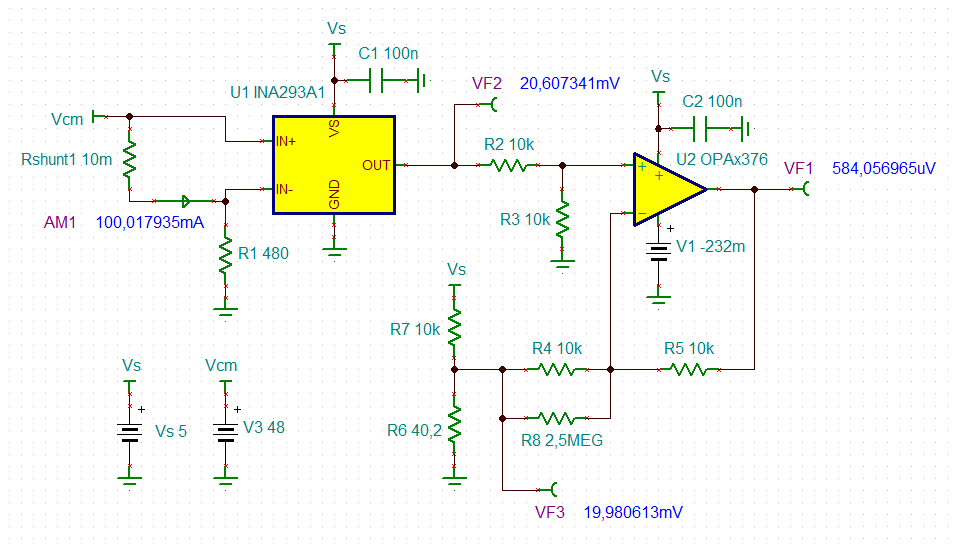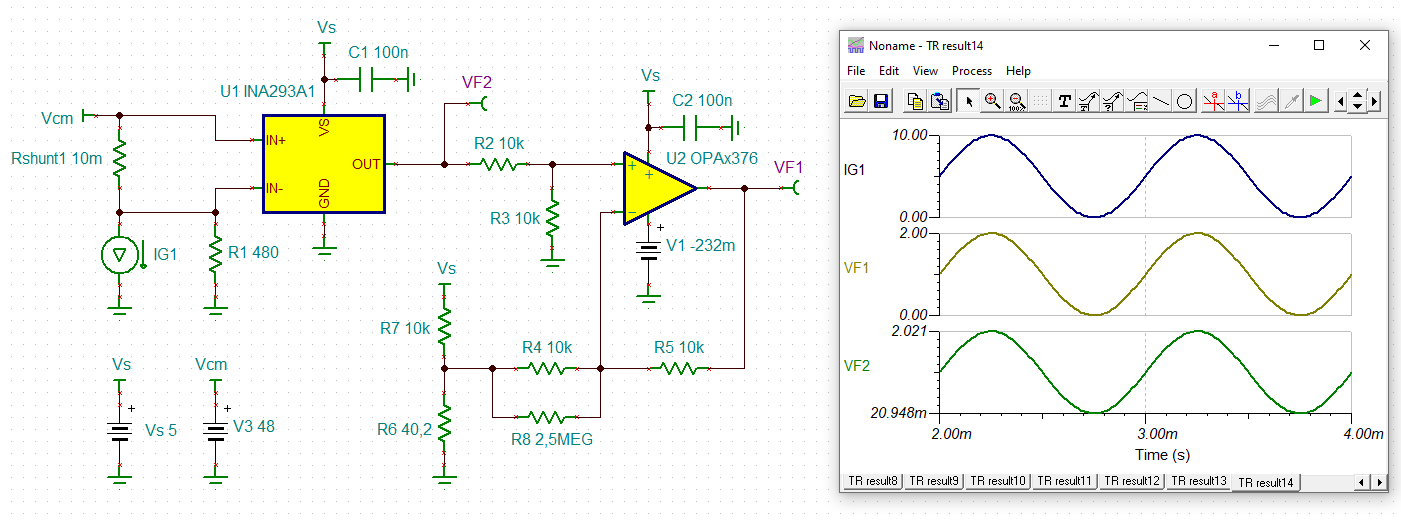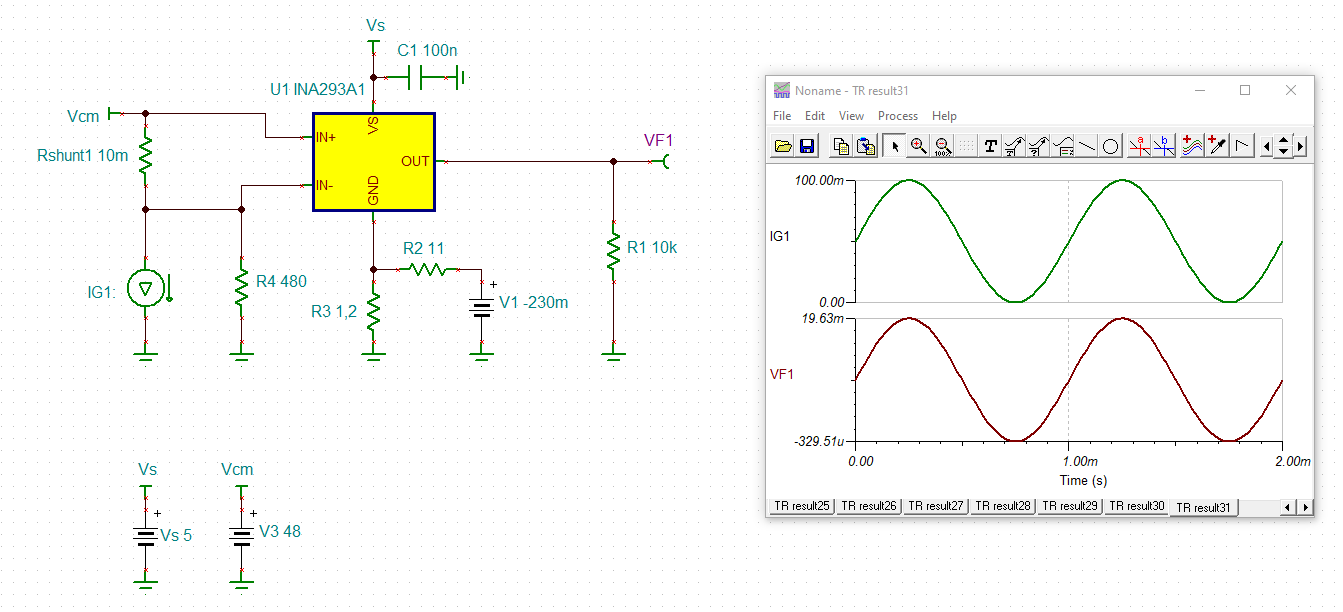Other Parts Discussed in Thread: LM7705, OPA376
Hi expert,
Is there any method/circuit to make INA293 output can go as low as ground, not 0.02V swing to ground? Thanks.

Regards,
Jiandong
This thread has been locked.
If you have a related question, please click the "Ask a related question" button in the top right corner. The newly created question will be automatically linked to this question.
Hi Jiandong,
you could add a level shifter with the negative supply pin of the level shifter being connected to LM7705 instead of GND. Or you could try to power the GND pin of INA293 itself with the LM7705.
Kai
Hi Kai,
Thanks for you strong support. So INA293 is not deigned only for single supply? What's the maximum negative supply could INA293 achieve? Thanks.
Regards,
Jiandong
Hi Jiandong,
the INA293 is designed for single supply -and don't understand me wrong- I don't want to recommend the operation with a bipolar supply voltage. The INA293 will not work with a bipolar supply voltage because of the internal current source anyway.
But no single supply chip can go all the way down to 0V at its output. So either you live with it or you must use a trick, like with the LM7705. The LM7705 provides only -0.232V. So this will not change much the effective supply voltage the INA293 is seeing.
Kai
Also, keep in mind that the output voltage of LM7705 is not entirely constant but changes with temperature and load current. So an added level shifter might be the better choice
Kai
Hi Kai,
Thanks for the explanation. I don't really understand how level shifter work. Do you have a reference circuit?
Thanks and Regards,
Jiandong
Hello Jiandong,
Keep in mind that if you change the low supply that the output will be referenced to that voltage. You will still be limited on measuring 0V at the input. If you want to measure a 0V at the input I would recommend a device that has a reference input and is bidirectional. Also keep in mind that VOS when you are trying to measure 0V input to give you 0 output. Vout swing will dominate at the low side but if you are concerned how low you can get the output you will need to realize that VOS will play a major part in the error at these low values.
You can create an artificial offset and get the output above zero when the input by placing a resistor in series but this will come at the cost of offset and gain error not being as good a the specification. You would then also need to calibrate that offset.
Hi Jiandong,
a level shifter could look like this:

R1 generates an offset current of 100mA. By this the output voltage of INA293 is shifted by 100mA x 10mR x 20 = 20mV, so that the output of INA293 is no longer going into saturation.
U2 forms a differential amplifier which substracts 20mV from the output signal of INA293. A small negative supply voltage of -0.232V allows the OPA376 to go all the way down to 0V.
The network R6, R7, R4 and R8 looks like a resistance of
R6 x R7 / (R6 + R7) + R4 x R8 / (R4 + R8) = 40.0R + 9960.2R = 10000.2R
R7 and R6 create an offset voltage (VF3) of 20.0mV.
For best precision +/-0.1% toleranced resistors should be used.
Here the behaviour with input load:

Unfortunately, this circuit has one major disadvantage: It only works properly when the common mode input voltage is nearly constant. When the common mode input voltage decreases, the offset current through R1 decreases as well and by this also the 20mV offset voltage at the output of INA293. To compensate for varying common mode voltages, the offset voltage could be chosen higher. But you still have to consider an unwanted offset voltage variation which looks like a degradation of common mode rejection ratio of INA293. So this scheme only seems to be useful when the common mode input voltage changes are negligible
Kai
Hi Kai,
Thanks for your strong support and clear explanation. I introduce these 2 solutions to customer and customer chose LM7705 at last. As you mentioned, LM7705 output voltage changes with temperature and load current. However, from datasheet, the max output voltage of LM7705 at all conditions will be lower than -0.2V, which is the maximum swing to negative supply voltage of INA293. So customer think LM7705 can help INA293 output zero at all conditions(not considering Vos here). Do you think is this analysis reasonable?Thanks!

Regards,
Jiandong
Hi Javier,
Thanks for the suggestions on Vos, customer will take it into account when design circuit.
Regards,
Jiandong.
Hi Jiandong,
I think I didn't understand what you said
What solution is the customer preferring? The first or the second with the OPA376?
Kai
Hi Kai,
Customer prefer the 1st solution with LM7705.
You mentioned, LM7705 output voltage changes with temperature and load current. From LM7705 datasheet, the max output voltage at all conditions will be lower than -0.209V.

From INA293 datasheet, the maximum swing to negative supply voltage of INA293 is 0.02V. 
As -0.209+0.02=-0.09volts, so customer think LM7705 can help INA293 output zero, no matter the temperature or load changes.
Do you think is this analysis reasonable? Thanks!
Regards,
Jiandong
Hi Jiandong,
yes, -0.209V + 20mV = -0.189V, which is still negative.
Nevertheless, the output might still have issues to work linearily down to zero sense current. Even if the output voltage is now negative, the output might go into saturation for very lowest sense currents.
Because of this, I would still recommend adding a dummy load to generate an offset, like shown below:

The offset current introduced by R4 causes the output voltage to rise to 20mV (relative to the GND pin of INA293), allowing the INA293 coming out of saturation. And the -20mV ground shift introduced by the voltage divider R2 and R3 in combination with LM7705 (-0.23V voltage source) makes the output of INA293 appear to be able to fully go down to 0V, without going into saturation.
Kai